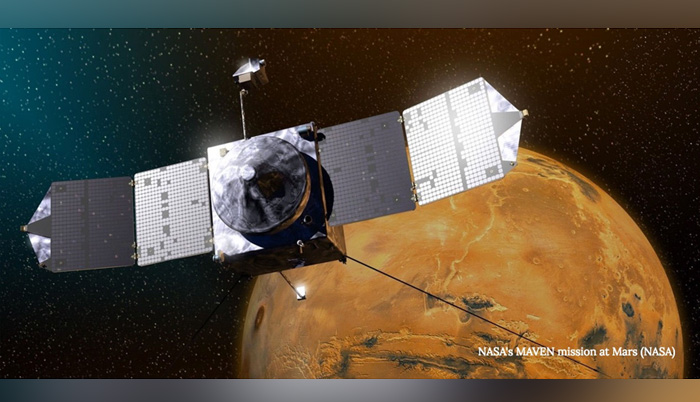![]() Home > Space & Science
Home > Space & Science
NASA's Next Mars Orbiter Is Being Planned for 2022

NASA's MAVEN mission at Mars. Credit: NASA
![]() December 16th, 2016 | 11:33 AM |
December 16th, 2016 | 11:33 AM | ![]() 1640 views
1640 views
SPACE.COM
NASA is planning on sending a new orbiter to Mars. It'll be a chance to replace some aging hardware and also to get some more amazing science images and data from the Red Planet, in anticipation of more robotic missions to Mars and a possible human mission in the 2030s.
While the full funding hasn't yet been approved for the new mission, the 2022 orbiter — referred to as the Next Mars Orbiter or "NeMO" — early conceptual work has been carried out. In July, NASA's Jet Propulsion Laboratory in Pasadena, Calif., awarded five $400,000 sub-contracts for concept studies, to five companies. But should it get final approval, what science will NeMO be tasked with?
1. Why go to Mars again?
While many would argue Mars is well-explored, there are several reasons to send another orbiter to the Red Planet in 2022. One of the main issues with spacecraft is, like all other machines, they eventually get old and break down. We have a robust network of spacecraft orbiting Mars right now, but in the future those spacecraft will eventually have issues and die. There is also a lot of science still to learn, such as how much water is on or near the surface, and whether the planet is habitable enough for humans to put a mission there in the 2030s.
It's no use having a spacecraft at Mars unless it can communicate with Earth, so the 2022 orbiter will make a vital technological step in helping spacecraft on the surface to relay data. NASA's Curiosity and Opportunity rovers are currently sending back amazing finds from the surface and NASA plans another Mars rover in 2020.
But the rovers' abilities to hail Earth directly are limited, meaning that most of their information has to be sent to an orbiting Mars spacecraft and then to Earth. That's all great, but the problem is Mars' telecommunications infrastructure is aging. Mars Odyssey arrived in 2001, and the Mars Reconnaissance Orbiter in 2006. While the newer MAVEN (Mars Atmosphere and Volatile Evolution Mission) arrived in 2014, it's always good to have a backup.
3. Probing for ice
One of the science objectives for the next orbiter is to better understand what sorts of shallow ground ice deposits can be found across the Red Planet, and especially how these change over long periods.
Knowing about the ice deposits is also useful for possible future human missions, which could live off the land in terms of using water instead of hauling it all from home. "The key resource is water, which could make significant contributions to sustainable exploration when used in such diverse applications as life support, surface construction, and propellants for surface operations and ascent from Mars," the Next Orbiter Science Analysis Group wrote in a report published online last year.
Because spaceflight is expensive, engineers are always looking for ways to make it cheaper. One possibility is to swap out the gas that is used at Mars. Instead of traditional rocket fuel, NASA is considering using solar electric propulsion (SEP). It's been used before in deep space missions (such as the Dawn spacecraft that visited asteroid Vesta and dwarf planet Ceres), but never at Mars.
The propulsion works off the electricity created by the spacecraft's solar arrays; this electricity ionizes xenon atoms that get pushed out the spacecraft's rear and thus, push the spacecraft. While it uses less fuel, orbital changes take longer to accomplish.
The NEX-SAG group suggests that SEP would increase the amount of mass and power available for other instruments, since this type of fuel requires less. Another benefit is NASA's desire to capture and tow asteroids in the future, which would likely be accomplished with SEP. Best to test that a lot before dragging space rocks around.
5. Learning more about Mars for science ... and human visits
In 2015, NASA announced that briny water flows on the surface of Mars. Looking at features known as recurring slope linae, they found evidence of hydrated salts left behind —strong evidence that these features are from liquid water. While the Mars Reconnaissance Orbiter has many years of observations of RSL, the key limitation is when it flies over these features — typically at 3 a.m. or 3 p.m. mean solar time. These aren't times of day which are consistent with when near-surface ground water is most abundant, which would be mid-morning or early afternoon, the NEX-SAG group points out.
There are other things that would be useful for future Martian explorers to know, such as how the atmosphere transports material or when major environmental transitions occurred. These are also science objectives the next orbiter would have, with an eye to better understanding the Martian climate overall — past, present and future.
Source:
courtesy of SPACE
by Elizabeth Howell
If you have any stories or news that you would like to share with the global online community, please feel free to share it with us by contacting us directly at [email protected]